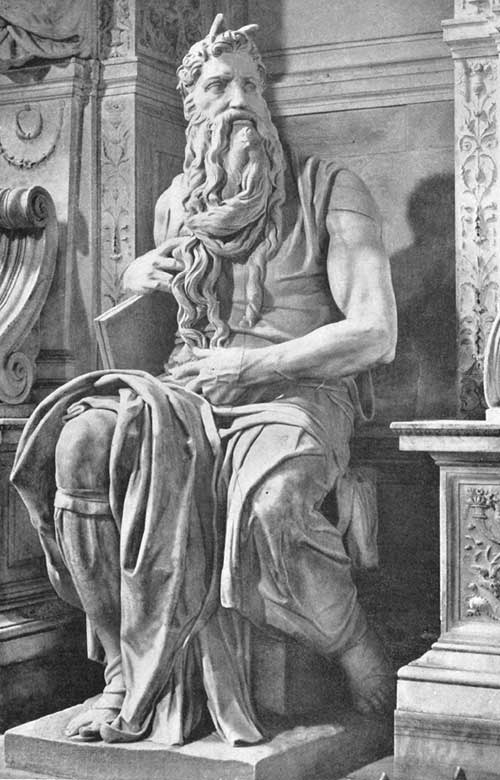IV
MOSES
In Michelangelo’s statue of Moses the great Hebrew leader is represented at the height of his career. He was a prophet, a poet, a military commander, and a statesman. The story of his life will show how all these qualities could be combined in one person.
At the time of his birth his people were in slavery to the Egyptians, who cruelly oppressed them. Their numbers were increasing so rapidly that it was feared they would soon outnumber their masters. So the command went forth to drown every boy baby. Now the mother of Moses had no mind to lose her boy, and “when she could not longer hide him, she took for him an ark of bulrushes, and daubed it with slime and with pitch, and she put the child therein and laid it in the flags by the river’s brink. And his sister stood afar off, to know what would be done to him.”[9]
Then a strange thing happened. The princess came to the river with her maids for a bath, and finding the babe, was touched by his cries. The sister came up as if by chance, and asked if she should seek a Hebrew nurse for the child, and when[20] the princess said Yes, she went straight for her mother.
So Moses was adopted by an Egyptian princess, yet he was nurtured in infancy by his own mother. This explains why, with all the Egyptian learning acquired at court, he had still the religious training of a Jew, and when he grew to manhood he was full of sympathy for the wrongs of his people. One day he saw an Egyptian smiting a Hebrew, and in his wrath he slew the Egyptian on the spot. News of the deed came to Pharaoh the king, and Moses fled into a place called Midian. Here for forty years he lived a quiet pastoral life as a shepherd for Jethro, whose daughter he had married.
Then came the divine call. He was alone with his sheep on the mountain-side, when he heard a voice saying, “Come now and I will send thee unto Pharaoh, that thou mayest bring forth my people the children of Israel out of Egypt,… and I will bring you up out of the affliction of Egypt unto the land of the Canaanites … unto a land flowing with milk and honey.”[10] Thus Moses became the leader of his people in their exodus, or departure from Egypt.
MOSES. Church of S. Pietro in Vincoli, Rome
After many strange experiences, the great company of emigrants made the passage of the Red Sea in safety, and Moses showed his poetic gifts in a song of triumph. Many years of slavery had taken the spirit out of the Hebrews, and they needed a wise head and a firm hand to govern them. Moses[23] had both, and he was, besides, a man of God. Going apart from them for a season of divine communion on the mountain, he spent forty days in preparation for a system of government. On his return he brought with him two tables of stone, inscribed with the ten great commandments, which are at the foundation of right character. He had also detailed directions for their daily conduct, and for their religious ceremonial.
The people for whose good all these plans were made were in the mean time discouraged by the long absence of their leader. They had no idea how much he was doing for them, and in their folly they forgot his teachings, and began to practise the idolatrous customs they had seen in Egypt. On descending the mountain, Moses found them worshipping the golden image of a calf. It is not to be wondered at that, as the historian says,[11] “Moses’ anger waxed hot, and he cast the tables out of his hands, and brake them beneath the mount.”
Again Moses went up into the mount for communion with God, and again two tables of stone were inscribed with the ten commandments, to replace those which had been destroyed. Again, also, he was gone forty days, and this time he was given a mysterious revelation of the goodness of God.
Thus it was that when he came down the people were afraid to come near, for[12] “the skin of his face shone,” or “put forth beams,” as the expression [24]reads in some Bible translations. In the old Latin version made by Jerome in the fifth century, and known as the Vulgate, translated into what is now called the Douay Bible, we read that “Moses’ face was horned.” This is why all the old artists, who were guided by the Vulgate, represented Moses with horns. These horns became, as it were, symbols of Moses’ inspiration as a prophet.
Michelangelo followed the prevailing custom in using these curious symbols. The long curling beard gives his hero the aspect of a poet. The tables of stone show him to be a law-giver. But of all the qualities of this many-sided man seen in the great statue, the most conspicuous are his qualities of leadership,—the keen glance, the commanding air, the alert attitude, the determined look. He seems ready to spring to his feet if occasion demands. We see also something of his faults, of the impulsive anger which slew the Egyptian, and dashed in pieces the tables of stone, and of the arrogance which cost him the privilege of entering Canaan.
He was not permitted to see his labors carried to completion, but on the borders of Canaan “went up into the mountain of Nebo,… and died there in the land of Moab, according to the word of the Lord. And he buried him in a valley … over against Beth-peor; but no man knoweth of his sepulchre unto this day.”
[9] Exodus, chapter ii. verses 3, 4, Revised Version.
[10] Exodus, chapter iii verses 10 and 17.
[11] Exodus, chapter xxxii. verse 19.
[12] Ibid., chapter xxxiv. verse 30. See Revised Version.

